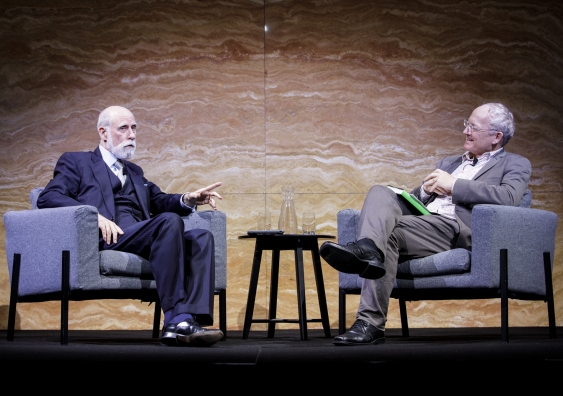The past, present and future of the internet

A “digital dark age” is looming unless a sophisticated regime for curating, preserving and accessing our data is established, the ‘father of the internet’, Vint Cerf has told a packed audience at UNSW Sydney.
Academics, students and researchers filled Leighton Hall at UNSW to hear Mr Cerf, Google’s chief internet evangelist, in conversation with UNSW Scientia Professor of Artificial Intelligence, Toby Walsh.
The event was held in partnership by UNSW Engineering and Google, and the pair spoke about the evolution and future of the internet, the Internet of Things and the challenges of digital security. Mr Cerf is the the co-designer, with Bob Kahn, of the TCP/IP protocols, the underlying communication language and the architecture of the internet.
Introducing Mr Cerf, UNSW Dean of Science Emma Johnston AO said: “In the ‘exploration of information’, Vint Cerf is one of the world’s great explorers. He co-invented the architecture and basic protocols on the internet. We are so fortunate today to hear from an innovator, a pioneer, an explorer, and a leader who has also given back.”
Professor Johnston highlighted the significant impact Mr Cerf has had on the world, largely because of decisions he and others made decades ago.
“The age of innovation that the world is experiencing now across so many fronts is a result of the ‘permissionless innovation’ that he and so many others were part of,” said Professor Johnston.
Mr Cerf discussed the early evolution of the internet, including the Advanced Research Projects Agency Network (ARPANET), the early packet switching network that linked many universities and research centres and became the technical foundation of the internet.
According to Mr Cerf, this was called “internetworking … but it was too long, so by December 1974 it became ‘the internet’.”
“The internet was initially academic and military communities – with no commercial traffic. I wanted to find a way to break that barrier … By the mid-1990s I remember being astonished as the world wide web began to take hold that people had knowledge they wanted to share with other people. They weren’t even asking to be compensated, they just knew it would be useful to other people.”
The wealth of information available eventually became such that “no one could find anything … That’s when we saw the development of search engines, such as Yahoo and Google, which came out of Stanford University.”
Mr Cerf warned the audience about the ongoing challenges of net neutrality, the idea that the internet must be kept open and not charged differently by user or content.
“Net neutrality is about preventing anti-competitive actions by internet service providers. At the moment there is no protection for anti-competitive behaviour. We must preserve basic net neutrality laws but we have a Congress that is having trouble passing legislation.”
Cerf drew attention to the complications of the rise of digital media and of the forthcoming “digital dark age”.
“We have a big problem – I call it the digital dark age – in that we don’t curate our digital content with much care until we realise its too late. So I’m a big fan of trying to create and preserve data, to assure ourselves that digital content can be moved from one medium to another – that we are able to preserve software. Creating a sophisticated regime for curating, preserving and accessing our data is just as important as preserving the original bits of data.”
This article was published by UNSW.
Lucy Carroll is the Media Advisor at the University of New South Wales. She was previously the health correspondent at the Sydney Morning Herald and holds a BSc in Design and Communication Studies from UNSW.













